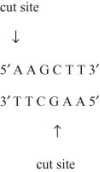Multiple Choice
In an experiment, DNA from the linear form of the bacteriophage Lambda was cut into fragments using the restriction enzyme Hind III. Hind III cuts the Lambda DNA between the adenine nucleotides on the complementary strands in a specific sequence, as indicated in the diagram, producing eight different size fragments. These fragments are then separated with an electrical current based on size after the DNA fragments are placed in a porous gel, a process called gel electrophoresis. 
Select an observation that best describes a correct aspect of the two processes of restriction
Digest and gel electrophoresis.
A) When separated on a gel, the pattern of DNA bands will be characteristic of those cut with Hind III; different restriction enzymes will not produce these same fragments.
B) The sequence 5′-AAGCTT-3′ is found eight times in the Lambda genome, and the restriction enzyme Hind III finds each location.
C) If an electrical current is not used, eight separate DNA bands would be visible, but they would not be separated as much as when an electrical current is used.
D) Only the restriction enzyme Hind III can be used to cut Lambda DNA since restriction enzymes are specific to the type of DNA they can cut.
Correct Answer:

Verified
Correct Answer:
Verified
Q3: What is the most logical sequence of
Q5: Which of the following correctly lists the
Q8: For a particular microarray assay (DNA chip),
Q11: For which of the following processes can
Q14: A principal problem with inserting an unmodified
Q15: Which of the following processes helps bacterial
Q23: Which of the following tools of DNA
Q32: Which of the following characteristics of short
Q48: Which of the following enzymes is required
Q57: Which of the following statements correctly describes